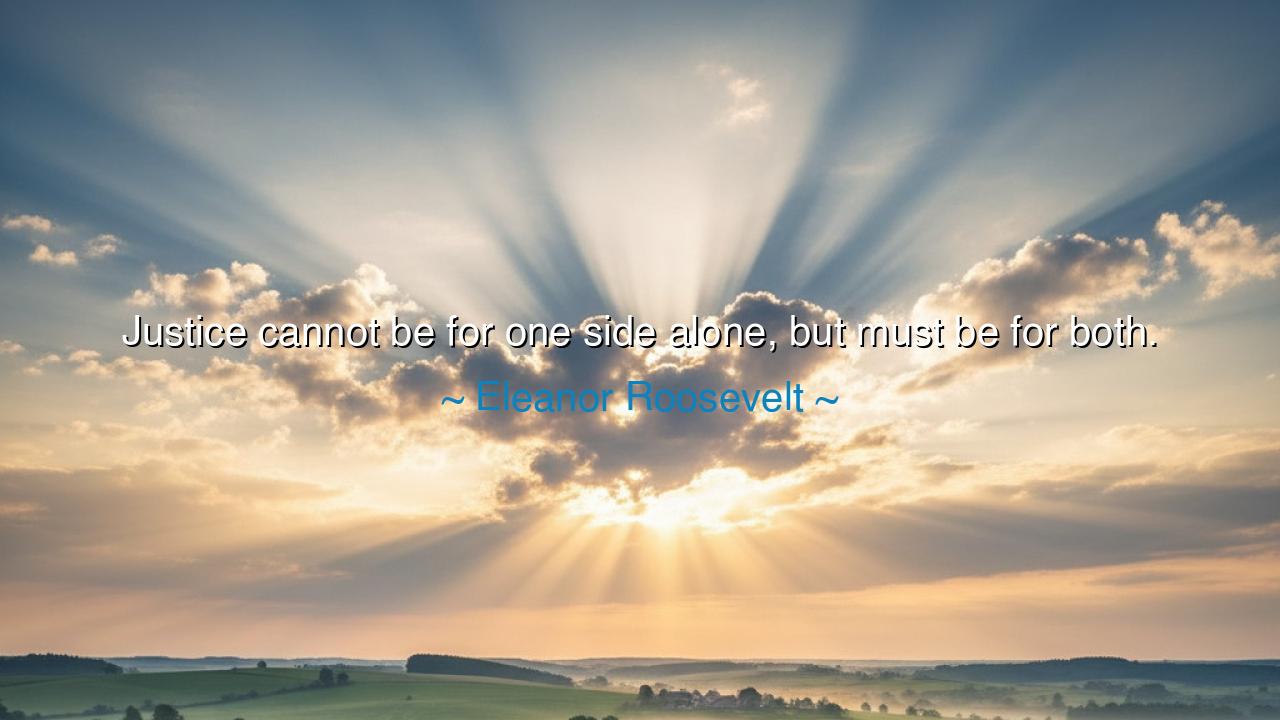
Justice cannot be for one side alone, but must be for both.






"Justice cannot be for one side alone, but must be for both." These stirring words, spoken by Eleanor Roosevelt, cut through the murk of partisanship and self-interest to reveal a fundamental truth: that true justice is not one-sided, it does not favor the few while ignoring the many. It is not a weapon to be wielded in the service of the powerful or the oppressed alone, but a universal force, extending its hand equally to all who seek it. Roosevelt’s wisdom, drawn from her lifelong fight for human rights and equality, speaks to the very soul of moral fairness and the equitable balance that is necessary for a just society.
What does it mean for justice to be for both sides? It is to understand that the law is not a mere tool of convenience for the powerful, nor is it a weapon of vengeance for the weak. Justice is the recognition that all people, regardless of their station, race, or creed, are entitled to be heard, to be treated fairly, and to stand before the law with the same dignity and opportunity. In every dispute, whether between nations, individuals, or communities, justice calls for balance, for each side to be given its due, and for the truth to rise above the noise of conflict and partisanship.
Consider the great historical example of the Nuremberg Trials that followed the Second World War. The world had witnessed unprecedented atrocities, and the desire for retribution against the perpetrators of such heinous acts was strong. Yet, the Nuremberg Trials, as painful as they were, set a precedent for justice that transcended mere vengeance. The trials did not seek to destroy one side in the name of another, but to establish a framework of fairness, where even the accused, despite their crimes, were entitled to a fair trial and legal defense. This act of applying justice to both sides—those who suffered and those who inflicted suffering—reminds us that justice, in its truest form, is never a tool of oppression, but a force of healing and reconciliation.
In the annals of history, there are countless examples of justice being denied to one side, with disastrous consequences. Take, for instance, the civil rights movement in America, where for generations, African Americans were denied the most basic rights and freedoms. Yet, even as they fought for equality, they did not call for the oppression of their oppressors, but for the equitable application of justice for both sides. Leaders like Martin Luther King Jr. knew that true justice meant not merely the end of one form of oppression but the creation of a society where all people, regardless of their race, were treated with dignity and respect. The pursuit of justice was not to punish one side, but to create a world where the principles of equality and fairness could guide the future.
This is the heart of Roosevelt's message: justice must transcend the narrow confines of personal or political gain and reach out to embrace the greater good of all. In every conflict, there are always two sides, each with their own perspective, their own needs, and their own truths. True justice recognizes this and strives for a balance, where each side is afforded the opportunity to present their case, where the law is not a tool of revenge but a means of reconciling differences. It is in this reconciliation that justice finds its highest expression.
So, what can we learn from Eleanor Roosevelt’s wisdom? The lesson is clear: justice is not an instrument to be wielded for one side’s advantage, but a sacred principle that must be applied equally to all. In our personal lives, when we find ourselves in conflict with others, we must strive not to defeat or dominate the other party, but to seek understanding and fairness. In our societies, we must work to ensure that the law serves all people, without bias or discrimination. Whether we are standing up for the oppressed or advocating for the powerful, our actions must be guided by the belief that true justice serves both, for it is only when both sides are treated with honor and respect that we can claim to live in a just world.
In practical terms, this means embracing empathy in every dispute, understanding that both sides have their own experiences and truths. It means working toward solutions that do not seek to impose one view over another but that seek to bridge the gap between them. It means ensuring that the law—in our courts, in our governments, and in our communities—is applied with fairness, integrity, and a deep commitment to the greater good of all people. For, as Roosevelt so wisely said, justice is not for one side alone—it is the birthright of all who walk this earth, and it is in the balance between us all that we find the true meaning of fairness and equity.






AAdministratorAdministrator
Welcome, honored guests. Please leave a comment, we will respond soon